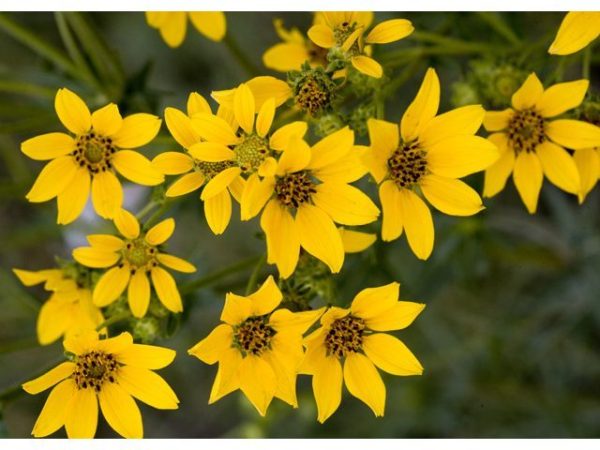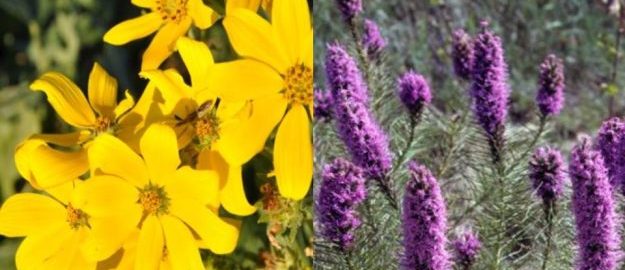As we plow into 2022, it’s time for citizen gardeners to cast a vote for this year’s Unofficial Pollinator Plant of the Year.
On the heels of Cowpen daisy (2019), Gregg’s purple mistflower (2020), and Frostweed (2021), the candidates for this year’s under-appreciated pollinator plant are:
Engelmann’s daisy and Gayfeather
Started in 2019 by the Texas Butterfly Ranch, the Unofficial Pollinator Plant of the Year campaign targets the need to raise awareness of the unsung plant heroes of the pollinator garden. Many worthy, native plants are frequently unavailable–ONLY found at seasonal pop-up plant sales. If you miss these occasional plant sales, you’re out of luck.

Spread the word by including a sign in your yard.
Commercial and retail nurseries cite “lack of demand” as the reason these plants are absent from their stores. Another reason is that some natives are persnickety to grow, sometimes taking two years to reach a mature enough stage to warrant customer interest.
That said, our Unofficial Pollinator Plant of the Year initiative aims to drive demand for more native plants at gardening centers, local nurseries and big box stores. We encourage you to request these plants when shopping to stock your landscape.
But first, please vote.
“Both candidates are worthy of the title, and it’s a win no matter which plant prevails,” said Lee Marlowe, president of San Antonio’s Native Plant Society chapter.
Both nominees, members of the Aster family, are excellent pollinator providers. They offer fuel for butterflies, bees and others. Both are drought tolerant and available in seed form, but generally not found as containerized plants–something we’d like to see change.
Engelmann’s Daisy, Engelmannia peristenia

Engelmann’s Daisy, photo by Al Braden, courtesy Ladybird Johnson Wildflower Center
This yellow bloomer sports jagged, saw-like leaves that inspire its other name: Cutleaf daisy.
Often included in general wildflower mixes because of its easy-to-grow-from-seed habit, Engelmann’s daisy blooms much of the year, depending on location. It needs full sun and a medium amount of water to get started. Once established, it tolerates drought and grows in calcareous and clay soils.
Versatile, low maintenance, and with a long bloom time, Engelmann’s daisy also sports deeply lobed, dark green leaves that can grow 6 – 12 inches long. Engelmann’s daisy usually reaches 2 – 3 feet in height and 2 – 3 in width.
NOTE: Deer and cattle graze on Engelmann’s high protein leaves.
Gayfeather, Liatris punctata var. mucronata

Gayfeather in full bloom. Photo by Native American Seed
Sprays of purple composite flowers adorn a long terminal spike and suggest Gayfeather’s other common name: Blazing star.
The drought tolerant native features feather duster like stems packed with small violet blooms that draw bees, butterflies and other insects. Gayfeather reaches 1 – 3 feet in height and blooms August through December. Birds enjoy its seeds in the winter and it’s known to have an extremely long tap root. It requires full sun and thrives in calcerous soils.
NOTE: Gayfeather is somewhat deer resistant.
So…a difficult choice, but what do you say?
We’ll report results in early February.
Get on the map with 731 other gardeners by signing up for our pollinator habitat challenge HERE.
Related articles:
- Mostly native urban pollinator garden outperforms lawn every time
- Flower “bed” works overtime as bachelor pad for solitary bees
- Trinational friendship garden woos pollinators and their fans to Confluence Park
- Doug Tallamy proposes crowdsourcing a homegrown national park: Who’s in?
- Paddling Lessons: documentary reveals the secret life of a river
- A monarch at my Abuela’s Day of the Dead altar
- Lost a loved one to COVID-19, social injustice or other causes? We’ll tag a butterfly in their name
- Monarch Butterfly and Pollinator Festival to remember those lost in 2019
Like what you’re reading? Don’t miss a single article from the Texas Butterfly Ranch. Sign up for email delivery at the bottom of this page, like us on Facebook, follow us on Twitter, @monikam or on Instagram.


More liatris!! Always the liatris! So many butterflies thrive on it.